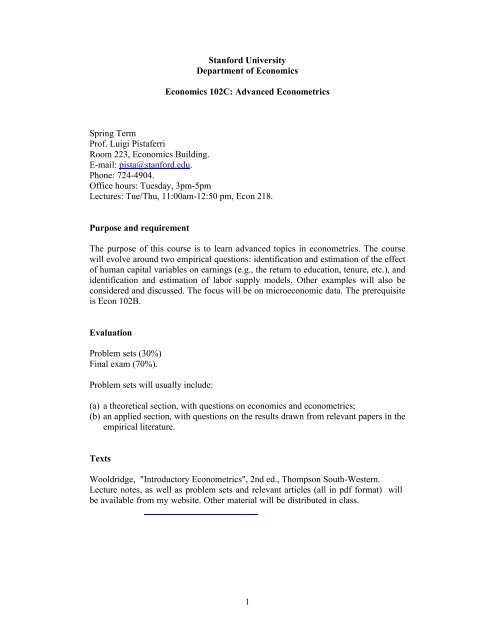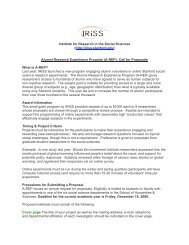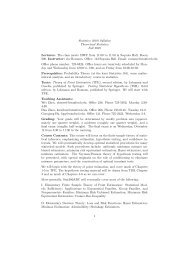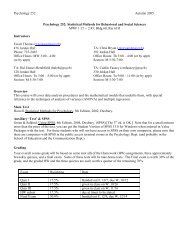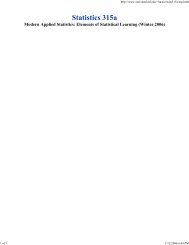Advanced Topics in Econometrics - Stanford University
Advanced Topics in Econometrics - Stanford University
Advanced Topics in Econometrics - Stanford University
You also want an ePaper? Increase the reach of your titles
YUMPU automatically turns print PDFs into web optimized ePapers that Google loves.
<strong>Stanford</strong> <strong>University</strong>Department of EconomicsEconomics 102C: <strong>Advanced</strong> <strong>Econometrics</strong>Spr<strong>in</strong>g TermProf. Luigi PistaferriRoom 223, Economics Build<strong>in</strong>g.E-mail: pista@stanford.edu.Phone: 724-4904.Office hours: Tuesday, 3pm-5pmLectures: Tue/Thu, 11:00am-12:50 pm, Econ 218.Purpose and requirementThe purpose of this course is to learn advanced topics <strong>in</strong> econometrics. The coursewill evolve around two empirical questions: identification and estimation of the effectof human capital variables on earn<strong>in</strong>gs (e.g., the return to education, tenure, etc.), andidentification and estimation of labor supply models. Other examples will also beconsidered and discussed. The focus will be on microeconomic data. The prerequisiteis Econ 102B.EvaluationProblem sets (30%)F<strong>in</strong>al exam (70%).Problem sets will usually <strong>in</strong>clude:(a) a theoretical section, with questions on economics and econometrics;(b) an applied section, with questions on the results drawn from relevant papers <strong>in</strong> theempirical literature.TextsWooldridge, "Introductory <strong>Econometrics</strong>", 2nd ed., Thompson South-Western.Lecture notes, as well as problem sets and relevant articles (all <strong>in</strong> pdf format) willbe available from my website. Other material will be distributed <strong>in</strong> class.1
COURSE OUTLINE(Note that some topics could be expanded or reduced)o A review of the course.o Matrix algebra and econometrics Operation with matrices and useful properties. Matrix transposition and matrix <strong>in</strong>version. Partitioned matrices. Matrix differentiation. The OLS problem with matrix algebra. Statistics and matrix algebra: some useful distributional results. The Gauss-Markov theorem. Inference <strong>in</strong> the OLS model. Prediction and goodness of fit. Maximum likelihood.Read<strong>in</strong>gsClass notes + Wooldridge Ch. 3-5Johnston, Chapters 4 and 5.o Instrumental variables Simultaneous equations models The identification problem Measurement error Method of moments estimation Difference tests Overidentification and overidentify<strong>in</strong>g restrictions Application: The economic return to school<strong>in</strong>gRead<strong>in</strong>gsClass notes + Wooldridge, Ch. 15 and 16.Griliches, Zvi (1971), “Estimat<strong>in</strong>g the returns to school<strong>in</strong>g: Some econometricproblems”, Econometrica 45, 1-22.Angrist, Joshua and Alan Krueger (1991), “Does compulsory school attendance affectschool<strong>in</strong>g and earn<strong>in</strong>gs?”, Quarterly Journal of Economics 106, 979-1014.Card, David (1995), “Us<strong>in</strong>g geographic variation <strong>in</strong> college proximity to estimate thereturn to school<strong>in</strong>g”, <strong>in</strong> Aspects of labor market behavior: Essays <strong>in</strong> honour ofJohn Vanderkamp, ed. By N. Christofides, E.K. Grant, and R. Swid<strong>in</strong>ski, Toronto:<strong>University</strong> of Toronto Press.2
o Panel data Pool<strong>in</strong>g time-series and cross-sectional data Fixed effects Random effects Dynamic models Application: The economic return to firm-specific human capitalRead<strong>in</strong>gsClass notes + Wooldridge, Ch. 13-14Altonji, Joseph and R.A. Shakotko (1987), “Do wages rise with job seniority?”,Review of Economic Studies 54, 437-59.Topel, Robert (1991), “Specific capital, mobility and wages: Wages rise with jobseniority”, Journal of Political Economy 99, 145-76.o Qualitative response models and limited dependent variables L<strong>in</strong>ear probability models Random utility and <strong>in</strong>dex function Maximum likelihood estimation Probit and logit estimation Application: High school graduation Truncated and censored distributions Tobit estimation Application: Self-selection and female labor supplyRead<strong>in</strong>gsClass notes + Wooldridge, Ch. 17Heckman, James (1979), “Sample selection bias as a specification error”,Econometrica 47, 153-62.Mroz, Thomas (1987), “The sensitivity of an empirical model of married women’shours of work to economic and statistical assumptions”, Econometrica 55, 765-99.3
Common Syllabus Elements for All Economics Courses.Beg<strong>in</strong>n<strong>in</strong>g with Autumn quarter, 2003-04, courses taught <strong>in</strong> the Department ofEconomics are covered by a common set of course management policies, laid out <strong>in</strong> thisdocument. For some years, the Department has been advis<strong>in</strong>g <strong>in</strong>structors to adopt thesepolicies; the current change is to put a default document <strong>in</strong> place where students can f<strong>in</strong>dit. Students are responsible for know<strong>in</strong>g and abid<strong>in</strong>g by these course policies.We have several goals <strong>in</strong> lay<strong>in</strong>g out a common set of policies. It frees up studentsto focus on learn<strong>in</strong>g Economics <strong>in</strong>stead of learn<strong>in</strong>g course policies. It frees up <strong>in</strong>structor,TA and staff resources for teach<strong>in</strong>g Economics <strong>in</strong>stead of expla<strong>in</strong><strong>in</strong>g course policies. Itmakes the system more uniform so students can th<strong>in</strong>k about the content of their studies<strong>in</strong>stead of about the system.Some of the policies set very clear and sharp boundaries, often because one goalis reduc<strong>in</strong>g the transaction costs associated with more discretionary policies. Otherpolicies are designed to rule out behaviors that beg<strong>in</strong>n<strong>in</strong>g students don’t fully realize are<strong>in</strong>appropriate.I. Attendancea. Courses have <strong>in</strong>dividual policies regard<strong>in</strong>g class attendance.b. Exam attendanceExam attendance at the specified time is required. There are a few very specificexceptions to this rule, and if you are request<strong>in</strong>g one of these exceptions you must emailthe course <strong>in</strong>structor, copy<strong>in</strong>g the director of undergraduate studies (tbres@stanford.edu).The exceptions, stated below, are health emergencies, deaths <strong>in</strong> the immediate family,<strong>Stanford</strong> bus<strong>in</strong>ess that takes you away from Campus, and documented disabilities. Thereare not exceptions other than for reasons listed below, e.g., not for students who areattend<strong>in</strong>g job <strong>in</strong>terviews or beg<strong>in</strong>n<strong>in</strong>g jobs or <strong>in</strong>ternships before the end of the term, orwho for other non-educational reasons would prefer not to be at the <strong>University</strong> when theexam is scheduled. S<strong>in</strong>ce the exceptions are narrow and clear cut, your email ask<strong>in</strong>g foran exception should be short and to the po<strong>in</strong>t.i. Death of an immediate family member at a time when attend<strong>in</strong>gservices requires you to travel away from campus. Immediatefamily members are your parents, sibl<strong>in</strong>gs, spouse, and children.ii. Health emergencies where you are unavoidably <strong>in</strong> the hospital orcl<strong>in</strong>ic dur<strong>in</strong>g the time of the exam. Vaden physicians will certifywhen students who have health emergencies were seen, byagreement with the Department. That (or similar, if you are <strong>in</strong>hospital) documentation should follow your email.iii. Absence from campus on <strong>Stanford</strong> bus<strong>in</strong>ess, for example, forathletic competition. Work through the AAC (Ms. Powell) <strong>in</strong>order to take your exam at the same time (or slightly earlier, ifabsolutely necessary) as other students <strong>in</strong> the course but <strong>in</strong> adifferent place.iv. Disabled students who are work<strong>in</strong>g through the DRC may, <strong>in</strong> somecircumstances, take exam<strong>in</strong>ations at a different place than the restof students. See DRC section below.
Students are responsible for mak<strong>in</strong>g sure, at the beg<strong>in</strong>n<strong>in</strong>g of the term, that theycan attend the exams. Register<strong>in</strong>g for a course means that you certify that you will bepresent for the exam (unless one of the explicitly stated exceptions above arises.)Economics courses enforce the every other seat rule for exam<strong>in</strong>ations, and examsare to be taken either <strong>in</strong> the exam<strong>in</strong>ation room or the designated overflow room if one isneeded.c. On Time exam attendanceStudents who arrive late will have less time to f<strong>in</strong>ish, f<strong>in</strong>ish<strong>in</strong>g at the same time asother students. Students who, through bad luck or bad plann<strong>in</strong>g, appear late for an examwill need to f<strong>in</strong>ish at the same time as other students.d. Withdrawals and Incompletes<strong>Stanford</strong> provides an option for students to withdraw from courses to do so;students may withdraw up to the end of the 8 th week of classes for any reason. Studentsmay request <strong>in</strong>completes after that deadl<strong>in</strong>e provided (1) the only work that is <strong>in</strong>completeis the course f<strong>in</strong>al exam or f<strong>in</strong>al paper and (2) there is a health emergency or a death <strong>in</strong>their immediate family (these are clear cut boundaries, see the precise boundaries under“exam attendance, above.) Students should promptly (once healthy and past <strong>in</strong>itialgriev<strong>in</strong>g) work out an arrangement for clear<strong>in</strong>g an <strong>in</strong>complete with the Professor. Thetypical arrangement is tak<strong>in</strong>g the f<strong>in</strong>al <strong>in</strong> the same course offered <strong>in</strong> a later term. The<strong>University</strong> rules about <strong>in</strong>completes, such as that they turn <strong>in</strong>to NP after a fixed period oftime, apply here.e. No make up exams, exams at second times.There are no make-up exams or exams at second times.f. Deadl<strong>in</strong>esLate work, whether problem sets, exams, papers, or other work, does not count forcourse credit. It gets a grade of zero. No exceptions.g. Weight<strong>in</strong>gWeight<strong>in</strong>g different aspects of students’ work is, like the rest of grad<strong>in</strong>g, anecessary evil. The relative weights on the different elements course work are set by the<strong>in</strong>structor. So are the rules that permit (or do not permit) dropp<strong>in</strong>g the lowest problem setscore. The department has no set weights.One department-wide rule is that, if the course permits dropp<strong>in</strong>g the lowestproblem set score, a student who has entered a course late and missed the first problemset drops that one, not a later one.h. Correct<strong>in</strong>g Errors <strong>in</strong> Grad<strong>in</strong>gErrors <strong>in</strong> grad<strong>in</strong>g occur, if very rarely; this section lays out rules and proceduresfor request<strong>in</strong>g a correction. The important general rule is that such a request shouldclearly and succ<strong>in</strong>ctly state the unambiguous error you believe has occurred.Errors <strong>in</strong> grad<strong>in</strong>g aris<strong>in</strong>g from illegible or garbled answers are not subject tocorrection.Students who have been graded <strong>in</strong>correctly should petition for a correction <strong>in</strong>writ<strong>in</strong>g to the Professor, copy<strong>in</strong>g the director of undergraduate studies(tbres@stanford.edu). Students must not approach either <strong>in</strong>structor or TA with an oralrequest before mak<strong>in</strong>g their written request. Requests should be extremely short andmust focus on the specifics of the grad<strong>in</strong>g error. Requests should occur with<strong>in</strong> a week of
the work be<strong>in</strong>g returned (for example, with<strong>in</strong> a week of the work be<strong>in</strong>g placed <strong>in</strong> theacademic office.)The entire graded work (problem set or exam<strong>in</strong>ation) should be resubmitted; thereis no guarantee that grades will rise as, statistically, positive and negative errors <strong>in</strong>grad<strong>in</strong>g are equally likely. If the request arises because you th<strong>in</strong>k different students havebeen graded differently, all the affected students should submit their work as a group(there is no guarantee that only upward adjustments will occur.)Note that this policy applies only to specific and unambiguous errors, not to suchitems as disputes over grad<strong>in</strong>g policies, protests about the form or content of anexam<strong>in</strong>ation, or claims of learn<strong>in</strong>g not displayed <strong>in</strong> the work. Requests for a correctionwhich do not state, with particularity and specificity, the error to be corrected will berejected.Here is the appropriate form of a request to correct an error grad<strong>in</strong>g: “Dear Prof.X: I am a student <strong>in</strong> your economics 999 course. I believe that the grades on mymidterm were added up <strong>in</strong>correctly. As you can see from the bluebook I left <strong>in</strong> yourmailbox, I have 25 on each of the four questions, but 73 on the exam. I have not spokenwith you or any of the TAs about this, and am copy<strong>in</strong>g the DUS on this email. S<strong>in</strong>cerely,Fred.”Requests after the end of the term are further limited by the <strong>University</strong>’s policies.See http://www.stanford.edu/dept/registrar/academic/grades.htmli. Honor Code IssuesThe Honor Code is a very important part of Student life, and the Department ofEconomics takes it seriously. The Department encourages course <strong>in</strong>structors to fullycomply with their responsibilities to honorable students under the Honor Code.Many <strong>in</strong>structors and TAs are very offended, to the po<strong>in</strong>t of suspect<strong>in</strong>g an HonorCode violation, when students ask for “h<strong>in</strong>ts” about future exams and problem sets.Don’t do th<strong>in</strong>gs (like this) which lead Professors and TAs to th<strong>in</strong>k ill of students.The Department reserves the right to undertake procedures that would catchviolations of the Honor Code should any arise, such as photocopy<strong>in</strong>g work before it hasbeen returned.j. Disability IssuesStudents with documented disabilities: Students who have a physical,psychological, or learn<strong>in</strong>g disability that may necessitate an academic accommodation orthe use of auxiliary aids and services <strong>in</strong> a class must <strong>in</strong>itiate the request with theDisability Resource Center (DRC), not with the <strong>in</strong>structor. The DRC will evaluate therequest along with the required documentation, recommend appropriate accommodations,and prepare a verification letter dated <strong>in</strong> the current academic term <strong>in</strong> which the request isbe<strong>in</strong>g made. Students should contact the DRC <strong>in</strong> the first week of the quarter as timelynotice is needed to arrange for appropriate accommodations. The DRC is located at 563Salvatierra Walk. Also see http://www.stanford.edu/group/DRC/Be sure that your <strong>in</strong>structor, the DRC, and you have a common understand<strong>in</strong>g, atleast two weeks before any exam<strong>in</strong>ation, of the precise logistical arrangements by whichyou will be accommodated.


